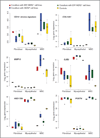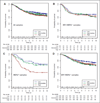Characterization and clinical evaluation of CD10+ stroma cells in the breast cancer microenvironment
- PMID: 22235100
- PMCID: PMC4446057
- DOI: 10.1158/1078-0432.CCR-11-0383
Characterization and clinical evaluation of CD10+ stroma cells in the breast cancer microenvironment
Abstract
Purpose: There is growing evidence that interaction between stromal and tumor cells is pivotal in breast cancer progression and response to therapy. Based on earlier research suggesting that during breast cancer progression, striking changes occur in CD10(+) stromal cells, we aimed to better characterize this cell population and its clinical relevance.
Experimental design: We developed a CD10(+) stroma gene expression signature (using HG U133 Plus 2.0) on the basis of the comparison of CD10 cells isolated from tumoral (n = 28) and normal (n = 3) breast tissue. We further characterized the CD10(+) cells by coculture experiments of representative breast cancer cell lines with the different CD10(+) stromal cell types (fibroblasts, myoepithelial, and mesenchymal stem cells). We then evaluated its clinical relevance in terms of in situ to invasive progression, invasive breast cancer prognosis, and prediction of efficacy of chemotherapy using publicly available data sets.
Results: This 12-gene CD10(+) stroma signature includes, among others, genes involved in matrix remodeling (MMP11, MMP13, and COL10A1) and genes related to osteoblast differentiation (periostin). The coculture experiments showed that all 3 CD10(+) cell types contribute to the CD10(+) stroma signature, although mesenchymal stem cells have the highest CD10(+) stroma signature score. Of interest, this signature showed an important role in differentiating in situ from invasive breast cancer, in prognosis of the HER2(+) subpopulation of breast cancer only, and potentially in nonresponse to chemotherapy for those patients.
Conclusions: Our results highlight the importance of CD10(+) cells in breast cancer prognosis and efficacy of chemotherapy, particularly within the HER2(+) breast cancer disease.
©2012 AACR.
Conflict of interest statement
No potential conflicts of interests were disclosed.
Figures





Similar articles
-
CD10-a new prognostic stromal marker in breast carcinoma, its utility, limitations and role in breast cancer pathogenesis.Indian J Pathol Microbiol. 2014 Oct-Dec;57(4):530-6. doi: 10.4103/0377-4929.142639. Indian J Pathol Microbiol. 2014. PMID: 25308002
-
Effect of neoadjuvant chemotherapy on stromal CD10 antigens in breast cancer - a preliminary study.Indian J Cancer. 2013 Jan-Mar;50(1):46-51. doi: 10.4103/0019-509X.112299. Indian J Cancer. 2013. PMID: 23713046
-
Prognostic impact of CD10 expression in clinical outcome of invasive breast carcinoma.Breast Cancer. 2015 Mar;22(2):117-28. doi: 10.1007/s12282-013-0459-1. Epub 2013 Apr 11. Breast Cancer. 2015. PMID: 23575921
-
Stromal cells in tumor microenvironment and breast cancer.Cancer Metastasis Rev. 2013 Jun;32(1-2):303-15. doi: 10.1007/s10555-012-9415-3. Cancer Metastasis Rev. 2013. PMID: 23114846 Free PMC article. Review.
-
Tumor-associated stromal cells as key contributors to the tumor microenvironment.Breast Cancer Res. 2016 Aug 11;18(1):84. doi: 10.1186/s13058-016-0740-2. Breast Cancer Res. 2016. PMID: 27515302 Free PMC article. Review.
Cited by
-
Tumoral CD10 expression correlates with high-grade histology and increases risk of recurrence in patients with stage I lung adenocarcinoma.Lung Cancer. 2015 Sep;89(3):329-36. doi: 10.1016/j.lungcan.2015.06.003. Epub 2015 Jun 15. Lung Cancer. 2015. PMID: 26141216 Free PMC article.
-
A comprehensive review of the literature on CD10: its function, clinical application, and prospects.Front Pharmacol. 2024 Feb 8;15:1336310. doi: 10.3389/fphar.2024.1336310. eCollection 2024. Front Pharmacol. 2024. PMID: 38389922 Free PMC article. Review.
-
CD10 Positive Recurrent Undifferentiated Mammary Sarcoma in a Young Female: A Rare Case Report with Brief Review of Literature.Rare Tumors. 2015 Jun 25;7(2):5737. doi: 10.4081/rt.2015.5737. eCollection 2015 May 5. Rare Tumors. 2015. PMID: 26266009 Free PMC article.
-
From ductal carcinoma in situ to invasive breast cancer: the prognostic value of the extracellular microenvironment.J Exp Clin Cancer Res. 2024 Dec 23;43(1):329. doi: 10.1186/s13046-024-03236-z. J Exp Clin Cancer Res. 2024. PMID: 39716322 Free PMC article. Review.
-
Tumoral CD10 expression correlates with aggressive histology and prognosis in patients with malignant pleural mesothelioma.Ann Surg Oncol. 2015 Sep;22(9):3136-43. doi: 10.1245/s10434-015-4374-x. Epub 2015 Jan 22. Ann Surg Oncol. 2015. PMID: 25608772 Free PMC article.
References
-
- Allinen M, Beroukhim R, Cai L, Brennan C, Lahti-Domenici J, Huang H, et al. Molecular characterization of the tumor microenvironment in breast cancer. Cancer Cell. 2004;6:17–32. - PubMed
-
- Casey T, Bond J, Tighe S, Hunter T, Lintault L, Patel O, et al. Molecular signatures suggest a major role for stromal cells in development of invasive breast cancer. Breast Cancer Res Treat. 2009;114:47–62. - PubMed
-
- Finak G, Bertos N, Pepin F, Sadekova S, Souleimanova M, Zhao H, et al. Stromal gene expression predicts clinical outcome in breast cancer. Nat Med. 2008;14:518–527. - PubMed
Publication types
MeSH terms
Substances
Grants and funding
LinkOut - more resources
Full Text Sources
Other Literature Sources
Medical
Molecular Biology Databases
Research Materials
Miscellaneous

